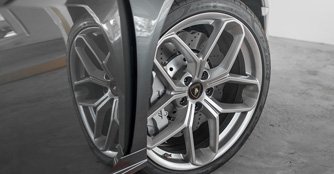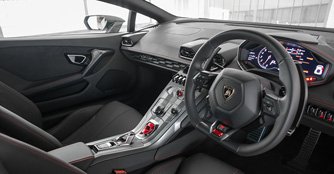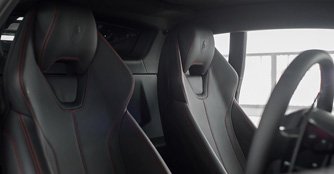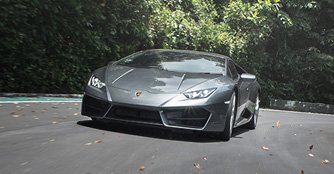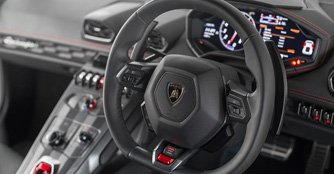Lamborghini Huracan LP 580-2 (A) Review
18 Apr 2016|36,060 views
The Huracan ('hurricane' in Spanish, pronounced 'hoo-ra-kahn') is Lamborghini's most affordable model that replaces the Italian carmaker's sales leader and most produced car, the Gallardo.
As with most recent Raging Bulls, it's named after a Spanish fighting bull, followed by its specific drivetrain configuration. Huracan was a fabled toro that fought in 1879 and was well-known for its courage, while LP stands for Longitudinale Posteriore in reference to the North/South facing engine located behind the driver.
And in this car you see here, 580 denotes the power (in PS) and 2 is the number of driven wheels. Dubbed Huracan LP 580-2, this new entry-level, rear-wheel drive car is by no means a surprising move from Sant'Agata Bolognese and it arrives as a spiritual successor to the Gallardo LP 550-2, which Lamborghini launched in 2010.
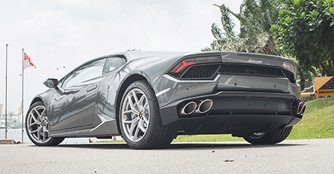
This is the third chapter in the Huracan's story, a car that follows the all-wheel drive LP 610-4 coupe and convertible, one that targets a fundamentally different audience.
Exterior
Visually, the LP 580-2 is just as stunning as the LP 610-4. But in order to differentiate them, Lamborghini gave the former a few unique touches in the form of revised sculpting of the front and rear fascia. The changes are discreet, but they're not invisible and a well-trained eye can easily tell the two models apart from a distance.
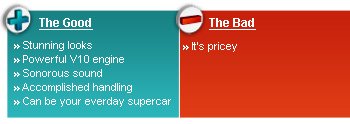 |
Both cars share the same muscular and planted Italian supercar look, but the LP 580-2 comes with redesigned air intakes at the front that are designed to increase downward pressure on the forward axle.
Meanwhile, its rear has a slightly thicker exiting air vent and a redesigned diffuser, and the bumper has received a few nip and tucks. While it looks every bit as loud and as fast as it is, the designers opted not to affix LP 580-2 emblems in front of the rear wheel arches in order to give the car a cleaner appearance.
So, chances are if you're happy with how the LP 610-4's looks, you'll have little to complain about with this car, although those miniscule changes do add a cool "guess if I'm the rear-wheel driven one" kind of style that we personally find quite appealing.
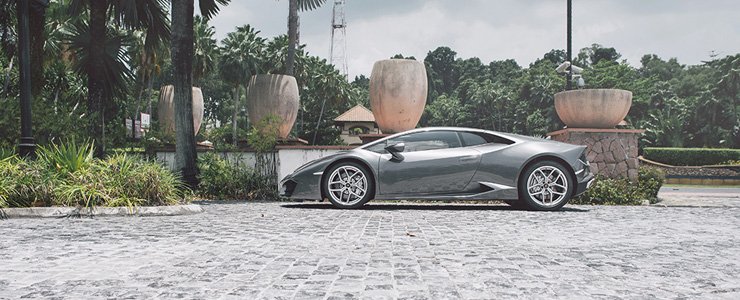 |
Interior
Drop into the low and firm sports seats of the Huracan and there's excellent forward visibility, but you'll need to order the optional transparent engine cover to see more out of the back.
One thing that makes the Huracan unique in its class is the digital dashboard with a customisable 12.3-inch TFT display, which combines most primary and secondary functions, similar to what you'll find in some of Audi's newer models.
Most of the controls, including the head light and indicator switches, can be found on the clever steering wheel that also features the three-way Adaptive Network Intelligent Management (Anima) drive mode toggle.
Everything else looks like it escaped from the cockpit of a fighter jet, which is a spectacular.
As the beneficiaries of the four-ringed German carmaker's well-documented prowess in craftsmanship and material quality, all Raging Bulls are assembled with fastidious attention to detail, with some of the world's best interior materials.
The bonnet pops up at the push of a button to reveal a surprisingly generous storage area. It offers 150 litres of space, so there isn't space for your golf clubs in there, but a couple of weekend bags will squeeze in without a problem.
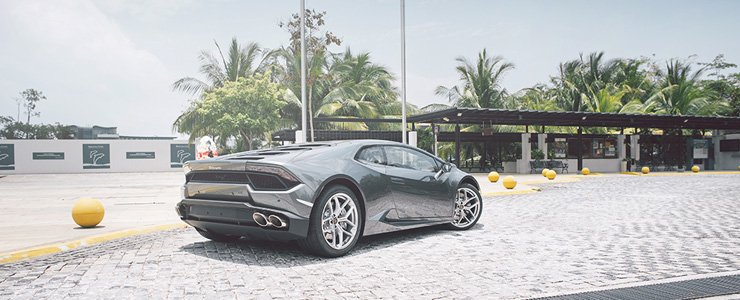 |
The Drive
In the downsized and turbocharged company that includes rivals such as the Ferrari 488 GTB, the McLaren 570S and the Porsche 911 Turbo, the Lamborghini is pretty unique for retaining its increasingly old-school naturally aspirated V10 engine configuration.
In this car however, the 5.2-litre unit in the LP610-4 has been mildly detuned to 571bhp and 540Nm of torque. It is paired with Lamborghini's Doppia Frizione (LDF) seven-speed dual-clutch transmission that delivers lightning fast and smooth gear cogs.
The word 'acceleration' may not be quite a powerful enough term for how quickly this Raging Bull gets up to three-digit speeds and beyond. 0 to 100km/h is now taken care of two-tenths of a second slower than the LP 610-4 but its top speed is still a sizeable 320km/h.
There is an astonishing amount of grip that remains despite the amount of power that rushes toward the back under full throttle and it sounds the part too with the V10's snarl gradually invading the cabin as the needle runs up the tachometer.
Power is applied progressively along three (Strada, Sport and Corsa) settings, which also affect steering weight, throttle response, the level of slip allowed by the traction control system and the stiffness of the suspension.
More impressively, the LP 580-2 feels balanced and fast, with a nice degree of adjustability engineered into its tail end but without it feeling edgy in any way. The relatively compact size of the Huracan also means it is easy to manoeuvre in the city and could actually be used as an everyday commuter car for its owner.
Conclusion
The Lamborghini Huracan LP 580-2 fulfills its mission as a thrilling and capable sports car. Its whole package is beautifully balanced and it offers an intuitive and fun drive.
More importantly, at $838,000 excluding COE (as of 7th April 2016), the car costs $190,000 lesser than the LP 610-4. That's good news for those lucky enough to be in this market because the LP 580-2 is as good as the Huracan gets.
The Huracan ('hurricane' in Spanish, pronounced 'hoo-ra-kahn') is Lamborghini's most affordable model that replaces the Italian carmaker's sales leader and most produced car, the Gallardo.
As with most recent Raging Bulls, it's named after a Spanish fighting bull, followed by its specific drivetrain configuration. Huracan was a fabled toro that fought in 1879 and was well-known for its courage, while LP stands for Longitudinale Posteriore in reference to the North/South facing engine located behind the driver.
And in this car you see here, 580 denotes the power (in PS) and 2 is the number of driven wheels. Dubbed Huracan LP 580-2, this new entry-level, rear-wheel drive car is by no means a surprising move from Sant'Agata Bolognese and it arrives as a spiritual successor to the Gallardo LP 550-2, which Lamborghini launched in 2010.
This is the third chapter in the Huracan's story, a car that follows the all-wheel drive LP 610-4 coupe and convertible, one that targets a fundamentally different audience.Exterior
Visually, the LP 580-2 is just as stunning as the LP 610-4. But in order to differentiate them, Lamborghini gave the former a few unique touches in the form of revised sculpting of the front and rear fascia. The changes are discreet, but they're not invisible and a well-trained eye can easily tell the two models apart from a distance.
Both cars share the same muscular and planted Italian supercar look, but the LP 580-2 comes with redesigned air intakes at the front that are designed to increase downward pressure on the forward axle.
Meanwhile, its rear has a slightly thicker exiting air vent and a redesigned diffuser, and the bumper has received a few nip and tucks. While it looks every bit as loud and as fast as it is, the designers opted not to affix LP 580-2 emblems in front of the rear wheel arches in order to give the car a cleaner appearance.
So, chances are if you're happy with how the LP 610-4's looks, you'll have little to complain about with this car, although those miniscule changes do add a cool "guess if I'm the rear-wheel driven one" kind of style that we personally find quite appealing.
Interior
Drop into the low and firm sports seats of the Huracan and there's excellent forward visibility, but you'll need to order the optional transparent engine cover to see more out of the back.
One thing that makes the Huracan unique in its class is the digital dashboard with a customisable 12.3-inch TFT display, which combines most primary and secondary functions, similar to what you'll find in some of Audi's newer models.
Most of the controls, including the head light and indicator switches, can be found on the clever steering wheel that also features the three-way Adaptive Network Intelligent Management (Anima) drive mode toggle.
Drop into the low and firm sports seats of the Huracan and there's excellent forward visibility, but you'll need to order the optional transparent engine cover to see more out of the back.
One thing that makes the Huracan unique in its class is the digital dashboard with a customisable 12.3-inch TFT display, which combines most primary and secondary functions, similar to what you'll find in some of Audi's newer models.
Most of the controls, including the head light and indicator switches, can be found on the clever steering wheel that also features the three-way Adaptive Network Intelligent Management (Anima) drive mode toggle.
Everything else looks like it escaped from the cockpit of a fighter jet, which is a spectacular.
As the beneficiaries of the four-ringed German carmaker's well-documented prowess in craftsmanship and material quality, all Raging Bulls are assembled with fastidious attention to detail, with some of the world's best interior materials.
The bonnet pops up at the push of a button to reveal a surprisingly generous storage area. It offers 150 litres of space, so there isn't space for your golf clubs in there, but a couple of weekend bags will squeeze in without a problem.
The Drive
In the downsized and turbocharged company that includes rivals such as the Ferrari 488 GTB, the McLaren 570S and the Porsche 911 Turbo, the Lamborghini is pretty unique for retaining its increasingly old-school naturally aspirated V10 engine configuration.
In this car however, the 5.2-litre unit in the LP610-4 has been mildly detuned to 571bhp and 540Nm of torque. It is paired with Lamborghini's Doppia Frizione (LDF) seven-speed dual-clutch transmission that delivers lightning fast and smooth gear cogs.
The word 'acceleration' may not be quite a powerful enough term for how quickly this Raging Bull gets up to three-digit speeds and beyond. 0 to 100km/h is now taken care of two-tenths of a second slower than the LP 610-4 but its top speed is still a sizeable 320km/h.
There is an astonishing amount of grip that remains despite the amount of power that rushes toward the back under full throttle and it sounds the part too with the V10's snarl gradually invading the cabin as the needle runs up the tachometer.
In the downsized and turbocharged company that includes rivals such as the Ferrari 488 GTB, the McLaren 570S and the Porsche 911 Turbo, the Lamborghini is pretty unique for retaining its increasingly old-school naturally aspirated V10 engine configuration.
In this car however, the 5.2-litre unit in the LP610-4 has been mildly detuned to 571bhp and 540Nm of torque. It is paired with Lamborghini's Doppia Frizione (LDF) seven-speed dual-clutch transmission that delivers lightning fast and smooth gear cogs.
The word 'acceleration' may not be quite a powerful enough term for how quickly this Raging Bull gets up to three-digit speeds and beyond. 0 to 100km/h is now taken care of two-tenths of a second slower than the LP 610-4 but its top speed is still a sizeable 320km/h.
There is an astonishing amount of grip that remains despite the amount of power that rushes toward the back under full throttle and it sounds the part too with the V10's snarl gradually invading the cabin as the needle runs up the tachometer.
Power is applied progressively along three (Strada, Sport and Corsa) settings, which also affect steering weight, throttle response, the level of slip allowed by the traction control system and the stiffness of the suspension.
More impressively, the LP 580-2 feels balanced and fast, with a nice degree of adjustability engineered into its tail end but without it feeling edgy in any way. The relatively compact size of the Huracan also means it is easy to manoeuvre in the city and could actually be used as an everyday commuter car for its owner.
Conclusion
The Lamborghini Huracan LP 580-2 fulfills its mission as a thrilling and capable sports car. Its whole package is beautifully balanced and it offers an intuitive and fun drive.
More importantly, at $838,000 excluding COE (as of 7th April 2016), the car costs $190,000 lesser than the LP 610-4. That's good news for those lucky enough to be in this market because the LP 580-2 is as good as the Huracan gets.
Car Information
Lamborghini Huracan LP580-2 (A)
CAT B|Petrol|8.4km/L
Horsepower
426kW (571 bhp)
Torque
540 Nm
Acceleration
3.4sec (0-100km /hr)
This model is no longer being sold by local distributor
All Used Lamborghini HuracanThank You For Your Subscription.
































